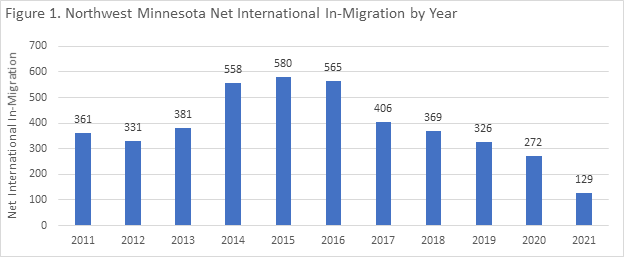 The presence of such industry powerhouses as Polaris, Arctic Cat and New Flyer make Northwest Minnesota a hub of transportation equipment manufacturing.
The presence of such industry powerhouses as Polaris, Arctic Cat and New Flyer make Northwest Minnesota a hub of transportation equipment manufacturing.
From wheat and potatoes to soybeans and sugar beets, the region is a major producer and processor of food staples and specialty agricultural products.
Want the freshest data delivered by email? Subscribe to our regional newsletters.
1/11/2023 9:00:00 AM
Anthony Schaffhauser
The defining feature of 2022's labor market was record tightness. Northwest Minnesota saw two new record low unemployment rates set in 2022: dropping to 1.7% in October, edging out the 1.8% record set in May and tied in September. That in turn broke 2021's two previous low records: 2.1% reached in October after 2.4% set just the prior month in September. Before 2021, the record low was 2.7%, first set in October 1999. So, if the 2021 records were extraordinary, 2022's records were astonishing.
With such a tight labor market, workforce and economic development partners are exploring ideas to help build the region's labor force back up again. Looking at population trends, what also may be astonishing is that reversing our region's international immigration declines would help get us most of the way back to pre-pandemic labor force trends. Net international immigration has been trending down since 2015, and it drastically dropped from 2020 to 2021 with the pandemic (see Figure 1).

At first glance, these immigration numbers – which hover between 100 and 600 people per year – seem entirely too small to impact our region, with a total of nearly 300,000 workers in the labor force. However, if we break down how our region's labor market got so tight, we can determine if reversing the immigration declines experienced since 2015 could have an appreciable impact.
Those who study our region's demographic and labor force trends have been talking about the tightening labor markets due to the aging population for over a decade. The supply of workers was set to decline as the Baby Boomers aged, and Northwest Minnesota's labor market has an outsized share of Boomers. According to generational definitions, Boomers were aged 56 to 74 in 2020, and about 26.3% of Northwest Minnesota's labor force was aged 55 to 74 in 2020, compared to 22.5% statewide and 21.5% for the entire U.S.
As a result, Northwest Minnesota's labor force was already projected to shrink by 5,850 workers, or -2%, from 2020 to 2030 based on population projections and 2019 labor force participation rates by age. Based on pre-pandemic trends, the region was expected to experience an average annual loss of 585 workers. Then in 2021 we saw a loss of over 8,390 workers due to changes and implications brought on by the pandemic. Combining these two estimates produces a roughly 7,800 worker pandemic-induced loss (the actual 8,390 loss minus the expected 585 loss.)
If over 5,000 workers of that 7,800 worker loss was due to early Boomer retirements, the declines would essentially be over. The projected labor force loss was front-loaded, and our region's labor force will hold steady through 2030 rather than decline. However, we see there are still a lot of Boomers working and the 55 to 74-year old age group in the labor force declined only an estimated 420 people between 2020 and 2021, based on U.S. Census American Community Survey data.
Clearly the pandemic impacted the labor force beyond early retirements. Fortunately, many workers returned to the labor force, analogous to the supply chain issues being worked out. We already have an over 1,400 worker gain for 2022 (based on the average labor force for the first eleven months). Since we would expect to lose around 585 workers, we remain down an estimated 5,815 workers. This reflects the 7,800 loss minus the 1,400 gained in 2022, minus the 585 workers we would have expected to lose in 2022 without the pandemic.
By that calculation, we would now be short roughly 730 workers per year through 2030 (5,815 divided by 8 years until 2030). Again, we expected to lose 585 worker per year, so that leaves an estimated 142 per year pandemic deficit. That means we just need to add roughly 140 workers per year for the remaining eight years until 2030 to be back to pre-pandemic trend. Where do we get 140 additional workers per year?
The average annual net international in-migration in the region from 2015 to 2019, which is the timeframe of our pre-pandemic labor force projections, was 449 people. However, immigration was consistently declining over that time, so the projections would include that downward trend. Let's conservatively assume the projections include 400 people per year from net in-migration. That is conservative because projections would incorporate a downward trend, not just 49 less than the average every year.
So, if our region got back to 2015 immigration levels, it would provide an additional 180 people (580 in 2015 minus the 400 people we projected. Over 93% of our region's foreign-born population is age 15 or older, based on the American Community Survey. That being the case, the 180 additional immigrants would provide 167 people aged 15 or older. We also know from previous research that foreign-born residents participate in the labor force at a 3.8% higher rate than native born.
However, even if we apply the 63.4% labor force participation rate for the entire age 16 and older population in Northwest Minnesota, these 180 immigrants would add 106 workers per year. Even with conservative assumptions, getting back 2015 net immigration levels would resolve 75% of the pandemic-induced labor force decline (106 additional immigrant workers per year divided by the 140 needed to get back to pre-pandemic trend).
Contact Anthony Schaffhauser at anthony.schaffhauser@state.mn.us.